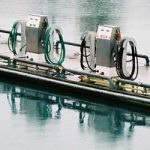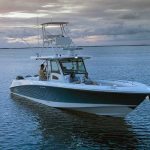All shore power cords should be rated suitable for Marine Use, or better still, “UL-Marine” listed for marine shore power applications.
Never use ordinary “outdoor use” extension cords to provide electrical shore power to the boat or any equipment, such as a battery charger on board the boat.
These cords are not rated for and are not suitable for the severity of a marine environment. They can deteriorate and/or overheat causing electrical shock, a short circuit, or a fire.
All shore power cords should have male (plug) and female (connector) ends of the locking type. Make sure that plugs and connector are turned to the fully locked position by pulling on them. If they are properly locked, they will not pull out. A plug or connector not properly locked will become loose and possibly cause arcing (sparks) on the contacts, resulting a failure and/or fire.
All male ends must be molded on or have weather-proof boots in order to provide a weatherproof seal when plugged into a receptacle.
All female connector ends must have a locking ring to secure the power cord to the inlet on the boat and provide a weatherproof seal.
Adapters should always be used at the shore end of a power cord.
Always make sure that the “Main” circuit breaker on the boat is turned “OFF” before connecting or disconnecting the shore power cord.
Always connect the female end of the cord to the boat before plugging the male end into the shore power receptacle. Always disconnect the male end from the shore power receptacle before disconnecting the female end from the boat.
Never leave a shore power cord on the dock with only the plug end connected. A live cord end is dangerous, especially if it accidentally falls into the water.
Periodically check shore power cords for the following:
Cuts, cracks, or severe abrasions on the yellow cord covering.
Bent, broken, or loose plug blades.
Plug blades or connector slots that show signs of overheating or arcing, such as:
Brown or black discoloration on insulation around blades or slots.
Discoloration and/or corrosion of blade material.
Faulty locking rings due to cracking or damaged threads.
Do not allow cords to be pinched by a closed door or hatch. Pinch points create resistance and generate heat that can result in a fire.
Never coil a live cord tightly on the dock. Such a coil acts as a heat generator and can cause a fire. Hang the cord loosely on a hook or support, or lay it out in a loose coil of only a few turns.
Spray all contacts monthly with an electrical contact cleaner, corrosion inhibitor and lubricant, such as LPS-1 made by Holt Lloyd Corporation. Please note that “WD-40” or silicone sprays are NOT appropriate because the filmy residue increases contact resistance. The proper spray types can be found at electrical supply houses or stores such as Radio Shack.
If a shore power cord should become immersed in water, it should be immediately rinsed or sprayed with fresh water, thoroughly dried, and the blades and contact slots sprayed with a moisture displacement before re-using.
Don’t use automotive parts to replace such items as starters, distributors, alternators, generators, carburetors, fuel pumps, etc., on your boat engine! They are not ignition protected and could cause a fire or explosion.








